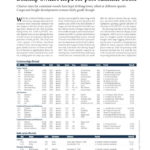Charter rates for container vessels have kept drifting lower, albeit at different speeds.
Cargo and freight developments remain fairly good, though
With the northern holiday season in full swing, tonnage demand from container lines remained subdued well into August, with time[ds_preview] charter rates falling faster. Based on the New ConTex, fixing levels for 1,100-4,250 TEU vessels slipped twice as fast during the last 4 weeks (as per 16 August) as during the previous 4-week period. The drop was -4.6%, against -2.3% before. Anecdotal evidence form chartering brokers suggests market activity in terms of number of fixtures is significantly down on last summer when container lines went on a fixing spree to ramp up route capacities, encouraged by improving world trade. Following an active period in the market and a shift from short/flexible to longer periods during the first half year, the charter sector’s tonnage situation has been stable enough to prevent disproportionate rate falls. A certain deterioration is normal during holiday season. Around 70 vessels were believed to be in spot position (in immediate need of fresh employment) by mid-August which, brokers say, was only a tad more than during August 2017. The overall »unused« capacity, including liner-controlled ships and tramp vessels that are commercially not available for various reasons (lay-up, repair etc.), has been fairly stable of late, with Alphaliner quoting a global idle fleet of 146 ships of 335,200TEU in early August.
The growing red ink in the Q2 results of container lines (Maersk, Hapag-Lloyd, Evergreen, OOCL etc.) is a clear indication of a tougher market environment. Freight rates kept lagging behind during the past 12 months as shipping lines added too much capacity while bunker prices went up. Also the growing trade tensions between the U.S. and the rest of the world and renewed Iran sanctions are posing demand side risks. Alphaliner: »Uncertainty over cargo volumes in the next few months has never been greater for carriers.« Purchasing manager indices, a barometer for economic activity, have been trending lower globally over the past months, remaining in positive territory (above the 50 point threshold indicating growth) in all important regions, except Brazil. Fundamental conditions appear not to be so much worse than in spring. Freight rates have picked up over the past weeks as the traditional peak season for deepsea services got underway. In the important transpacific trade, spot freights have surged since liner carriers closed down services since end-June. Whether it will be sufficient in combination with volume growth to lift carriers’ Q3 results into the black, remains to be seen. General outlook appears not to be so bad unless the trade war escalates further.
Regarding charter market activity and rate trends, the picture in mid-August is more varied than overall index movements suggest. Pressure has not let up for the very large gearless sectors (trad. post-panamax) and feeder/handy-types below 2,000TEU. Rate levels for 3,500TEU and for geared 2,500TEU ships seem to have stabilised as tonnage availability remains tight or at least manageable. Panamax container ships experienced an uptick in demand, supported by new service launches between Asia and Australia. This helped push down spot availability to 4 units as per early August.
A fine balance between supply and demand in the 3,000–3,700 TEU sector saw rate levels moving sideways, at least in the Atlantic where tonnage is scarce. The strength of the sector in that region has been underlined by a few charter transactions for gearless and geared units at mid/upper 12,000’s $/d versus low 11,000’s $/d in Asia. In the same vein, geared 2,500 TEU units were able to maintain rate levels over 12,000 $/d in the Atlantic versus mid-low 11,000 $/d in Asia where supply is more relaxed. Modern fuel-efficient designs suffered a minor deterioration, as illustrated by the extension of the SDARI 2500 type Nordpacific by Marfret for its Europe/Americas/New Zealand service with CMA CGM at 14,600 $/d – slightly down from the previous 15,000 $/d benchmark.
The development in the gearless 2,800TEU sector is puzzling experts, with rates falling below 11,000 $/d in most cases despite relatively scant supply (2 units spot + 2 geared, early August). Brokers suggest that low availability levels could see rates for this type make a sharp reversal if demand picks up after summer.
The situation for smaller vessels below 2,000TEU (often feeder services) has been more difficult. Some types and regions (1,700TEU Asia, 1,000TEU North Europe) are suffering more than others, but none really bucks the trend so far. Hamburg’s Ernst Russ Shipbroker explains this with a pronounced seasonality in cargo volumes particularly in September. In its latest Maritime Overview it writes that trading activity in the feeder sectors tends to slip by around 5% during that month before it gets busier again thanks to peak season transhipment volumes from October.
In the largest gearless segments above 5,500TEU there has also been a notable aggravation as more tonnage gets released due to service closures in the transpacific. The situation has turned worse both for smaller and larger post-panamaxes, with standard 8,500TEU ships registering a fall in rates to just 15,000’s $/d for short period while modern 6,800TEU wide-beams got marked down to 17,500 $/d – down several thousand dollars for both types within 6–8 weeks. mph


















